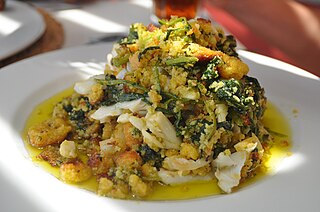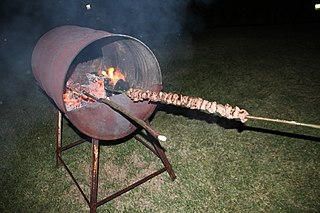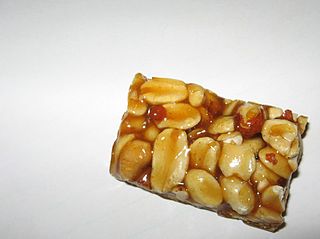
Brazilian cuisine is the set of cooking practices and traditions of Brazil, and is characterized by European, Amerindian, African, and Asian influences. It varies greatly by region, reflecting the country's mix of native and immigrant populations, and its continental size as well. This has created a national cuisine marked by the preservation of regional differences.

The oldest known book on Portuguese cuisine, entitled Livro de Cozinha da Infanta D. Maria de Portugal, from the 16th century, describes many popular dishes of meat, fish, poultry and others.

Portuguese sweet bread refers to an enriched sweet bread or yeasted cake originating from Portugal. Historically, these sweet breads were generally reserved for festive occasions such as Easter or Pentecost and were typically given as gifts. However, in contemporary times, many varieties are made and consumed year round. Outside of Portugal, Portuguese "sweet bread" translated as "pão doce" is often associated with Azorean "massa sovada" which are similar but traditionally prepared differently.

Mexican rice, also known as arroz a la mexicana, arroz mexicano, sopa de arroz, or arroz rojo in Spanish, is a Mexican side dish made from white rice, tomato, garlic, onion, and perhaps other ingredients. Mexican rice is almost always eaten as a complement to other dishes such as mole, refried beans, rotisserie chicken, carne asada, picadillo, tacos, fried fish, fried chicken, chiles rellenos, or vegetable soup.

Pão de queijo or Brazilian cheese balls is a small, baked cheese roll or cheese ball, a popular snack and breakfast food in Brazil. It is a traditional Brazilian recipe, originating in the state of Minas Gerais.

Espetada is the Portuguese term used for the technique of cooking food on skewers, and for the dishes prepared that way. Espetada is a traditional dish in Portuguese cuisine.

Pé de moleque is a traditional candy from Brazil. It is made of peanuts and rapadura or molasses.
Goan cuisine consists of regional foods popular in Goa, an Indian state located along India's west coast on the shore of the Arabian Sea. Rice, seafood, coconut, vegetables, meat, bread, pork and local spices are some of the main ingredients in Goan cuisine. Use of kokum and vinegar is another distinct feature. Goan food is considered incomplete without fish.

Goan Catholic Cuisine is the cuisine of the Goan Catholic community and is largely influenced by Portuguese cuisine. Due to over 450 years of Portuguese rule, the cuisine of Goan Catholics is dominated by ingredients and techniques of Portuguese cuisine like deep-frying, oven-baking, pork, vinegar, egg-based desserts, alcohol, etc.

Ecuadorian cuisine is diverse, varying with altitude and associated agricultural conditions. Ecuadorian cuisine is an amalgamation of Spanish, Andean, and Amazonian cuisines and to a lesser degree Italian, Lebanese, African, and Chinese. Beef, chicken, and seafood are popular in the coastal regions, especially ceviche, and are typically served with carbohydrate-rich foods, such as rice accompanied with lentils, pasta, or plantain. In the mountainous regions pork, chicken, beef and cuy are popular and are often served with rice, maize, or potatoes. A popular street food in mountainous regions is hornado, consisting of potatoes served with roasted pig. Some examples of Ecuadorian cuisine in general include patacones, llapingachos, and seco de chivo. A wide variety of fresh fruit is available, particularly at lower altitudes, including granadilla, passionfruit, naranjilla, several types of banana, uvilla, taxo, and tree tomato.

Mocotó is a Brazilian dish made from cow's feet, stewed with beans and vegetables. The name is derived from the Kimbundu mbokotó.

Canja de galinha, or simply canja, is a popular chicken soup of Portuguese, Cape Verdean, and Brazilian cuisine. The Portuguese term galinha literally means "hen", but became the generic name for the species, much like chicken in English. Portuguese chicken congee has the rice much more cooked than in most Western chicken soup recipes, but it is not disintegrated as in the Asian one.

Angolan cuisine has many dishes popular among nationals and foreigners, including funge, mufete, calulu, moamba de galinha, moamba de ginguba, kissaca, and mukua sorbet.

Bolo de arroz is a Portuguese rice muffin, common in Portugal, the Lusosphere countries and regions and countries with significant Portuguese immigrant populations, such as Canada, Australia, Luxembourg, the United States, and France, among others.

Conventual sweets are a typical part of the Portuguese cuisine and a generic term to a variety of sweets in Portugal. As the name implies, conventual sweets were made by nuns who lived in the Portuguese convents and monasteries. Starting in the 15th century, these sweets have since integrated in the Portuguese cuisine and in former Portuguese colonies. Conventual sweets have sugar, egg yolks and almond as ingredients of choice.

Favela Brazilian Cafe is a Brazilian restaurant in Portland, Oregon.





































































